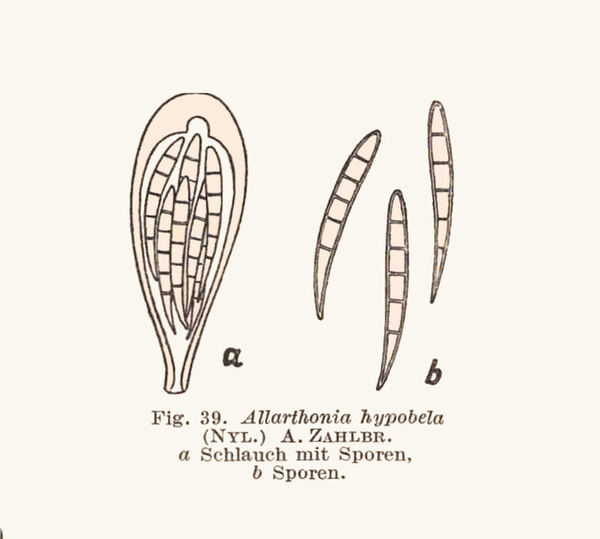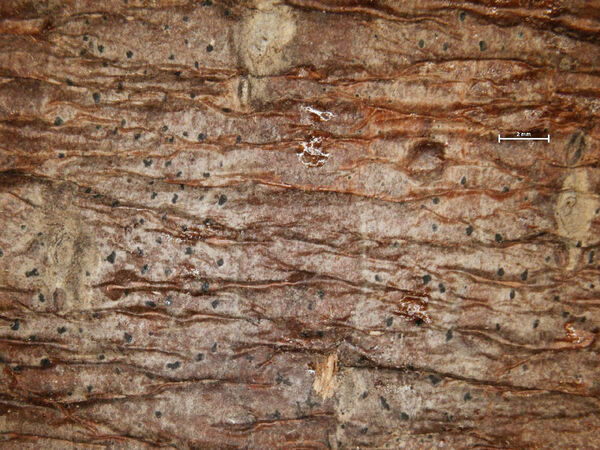Arthonia hypobela Nyl.
Flora, 59: 576, 1876.
Synonyms: Allarthonia hypobela (Nyl.) Zahlbr.
Distribution: C - Sar (Rizzi & al. 2011, Di Nuzzo & al. 2022).
Description: Thallus crustose, probably not lichenized, mostly endosubstratic and poorly evident, or very thin and forming poorly delimited, whitish patches. Apothecia arthonioid, black, epruinose, rounded to irregular in outline but not stellate-branched, mostly flat, 0.1-0.3 mm across. Proper exciple poorly developed, of dark hyphae; epithecium brown-black, 12-15 µm high, with granules; hymenium colourless, not inspersed with oil droplets, c. 50 µm high, I+ blue; paraphysoids branched and anastomosing, thread-like, the apical cells not swollen; hypothecium colourless to pale brown, c. 15 µm high. Asci 8-spored, broadly clavate, semi-fissitunicate, with a large apical dome, and a distinct ocular chamber Arthonia-type. Ascospores 3-5 septate, slightly wider at one end and often elongated at the other, hyaline, long spindle-shaped, straight or slightly curved, 30-38 x 4-5 µm. Photobiont probably absent (according to some authors a chlorococcoid photobiont may be present). Spot tests: thallus K-, C-, KC-, P-, UV-. Chemistry: without lichen substances.Note: a rather poorly known, probably western species growing on acid bark, including that of conifers; the Italian material was collected on Quercus pubescens and Q. suber. It is included in the Italian red list of epiphytic lichens as “Data Deficient” (Nascimbene & al. 2013c).
Growth form: Crustose
Substrata: bark
Photobiont: green algae other than Trentepohlia
Reproductive strategy: mainly sexual
Most common in areas with a humid-warm climate (e.g. most of Tyrrenian Italy)
Poorly known taxon in need of further study
Commonnes-rarity: (info)
Alpine belt: absent
Subalpine belt: absent
Oromediterranean belt: absent
Montane belt: absent
Submediterranean belt: absent
Padanian area: absent
Humid submediterranean belt: extremely rare
Humid mediterranean belt: extremely rare
Dry mediterranean belt: absent

Predictive model

Smithsonian Institution, National Museum of Natural History, Department of Botany – CC BY-SA-NC 3.0 http://collections.mnh.si.edu/search/botany/?irn=2871820
Growth form: Crustose
Substrata: bark
Photobiont: green algae other than Trentepohlia
Reproductive strategy: mainly sexual
Most common in areas with a humid-warm climate (e.g. most of Tyrrenian Italy)
Poorly known taxon in need of further study
Commonnes-rarity: (info)
Alpine belt: absent
Subalpine belt: absent
Oromediterranean belt: absent
Montane belt: absent
Submediterranean belt: absent
Padanian area: absent
Humid submediterranean belt: extremely rare
Humid mediterranean belt: extremely rare
Dry mediterranean belt: absent

Predictive model

 Index Fungorum
Index Fungorum
 GBIF
GBIF



